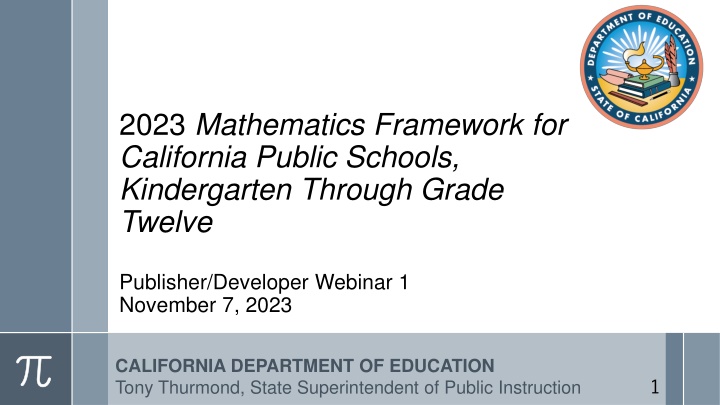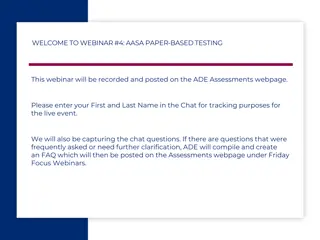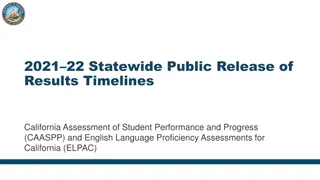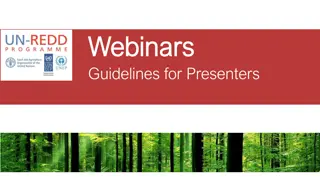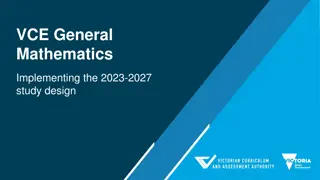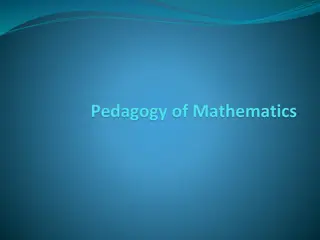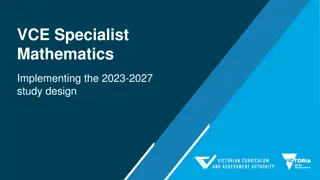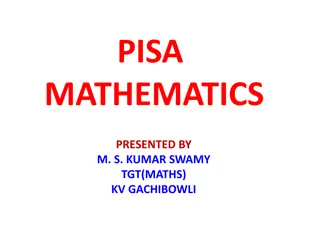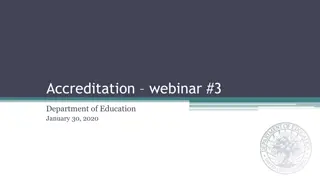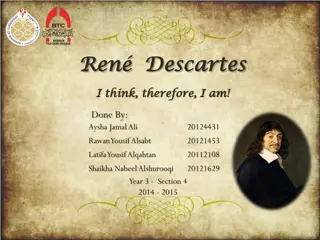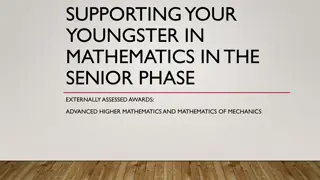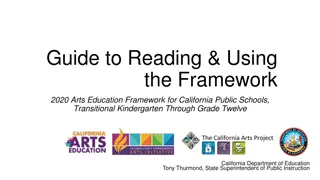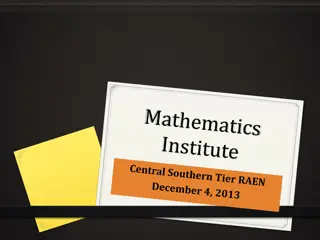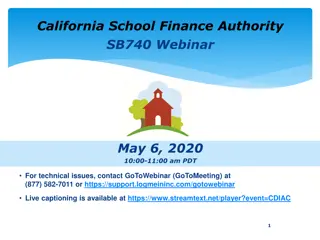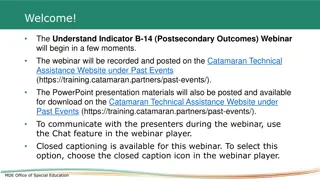Overview of 2023 Mathematics Framework Webinar by California Department of Education
California Department of Education held a webinar to introduce the 2023 Mathematics Framework for Public Schools. Key points covered include core ideas, guidance for instructional planning, chapters overview, and the purpose of the webinar. The framework emphasizes effective and equitable math instruction to help students achieve proficiency from TK to Grade 12. Resources and upcoming webinars for content developers were also highlighted.
Download Presentation

Please find below an Image/Link to download the presentation.
The content on the website is provided AS IS for your information and personal use only. It may not be sold, licensed, or shared on other websites without obtaining consent from the author.If you encounter any issues during the download, it is possible that the publisher has removed the file from their server.
You are allowed to download the files provided on this website for personal or commercial use, subject to the condition that they are used lawfully. All files are the property of their respective owners.
The content on the website is provided AS IS for your information and personal use only. It may not be sold, licensed, or shared on other websites without obtaining consent from the author.
E N D
Presentation Transcript
2023 Mathematics Framework for California Public Schools, Kindergarten Through Grade Twelve Publisher/Developer Webinar 1 November 7, 2023 CALIFORNIA DEPARTMENT OF EDUCATION Tony Thurmond, State Superintendent of Public Instruction 1
Presenters Dr. Mike Torres, Director Curriculum Frameworks & Instructional Resources Division Dr. Marla Clayton Johnson, Education Administrator Instructional Materials and Access Unit Carrie Marovich, Education Programs Consultant Standards and Curricular Guidance Unit Johanna Harder, Education Programs Consultant Standards and Curricular Guidance Unit 2
Upcoming Webinars for Content Developers November 28, 10:30 a.m. 12:30 p.m. The Big Ideas of the 2023 Mathematics Framework Kindergarten Grade 5 Grades 6 8 December 19, 10:30 11:30 a.m. Instructional Materials to Support Systemic Improvement in Mathematics 3
Resources on CDE Website 2023 Mathematics Framework Summary Chapters and appendices Instructional materials evaluation criteria (Ch 13) Frequently Asked Questions Framework related (on California Department of Education [CDE] website) Instructional materials adoption (forthcoming) 4
Purpose of Today's Webinar 1. Introduce the Mathematics Framework and its Core Ideas 2. Describe the Guidance for Instructional Planning in the Mathematics Framework 3. Provide an Overview of the Chapters 5
Guidance on implementing mathematics standards in grades TK 12 Guidance on development and evaluation of instructional materials Grounded in research and experience of California math educators Offers effective and equitable practices in math instruction Goal is to help students achieve proficiency and become powerful users of mathematics WHAT IS THE 2023 MATHEMATICS FRAMEWORK FOR CALIFORNIA PUBLIC SCHOOLS ? 7
Core Ideas of the 2023 Mathematics Framework (1) All students can achieve and be successful in mathematics and are encouraged to get as far and deep into mathematics as possible. Emphasis on equity and access in mathematics instruction woven throughout Culturally responsible instruction should build from student assets and enable growth-mindset Standards-aligned content is organized around Big Ideas at each grade level. Big Ideas enable rigor, focus, and coherence across grade levels 8
Core Ideas of the 2023 Mathematics Framework (2) Inquiry-based instruction Teaching structured through Standards for Mathematical Practice, Drivers of Investigation, and Content Connections Real world connections support student curiosity and inquiry Data Science and data use in math instruction Allows more focused treatment of (especially) statistics standards across grade levels 9
Core Ideas of the 2023 Mathematics Framework (3) Authentic problem-solving, multidimensional teaching, and other engagement strategies reach all students. Vignettes and practical examples help teachers understand and apply these ideas Technology and distance learning increase options for high- quality instruction Pathways and course options allow students to achieve, up to Calculus (or an alternate course of their interest) 10
Mathematics Framework Guidance for Instructional Planning 11
The Big Ideas Identify overarching mathematical concepts at each grade level Include clusters of content standards Connect mathematical concepts Intend to support multidimensional teaching and authentic problem solving 12
Grade 6 Big Ideas Link to long description 13
THE WHY, HOW, AND WHAT OF MATHEMATICS INSTRUCTION Link to long description 14
Drivers of Investigation (1) Link to long description 15
Drivers of Investigation (2) 1.Make sense of the world (understand and explain) 2. Predict what could happen (predict) 3. Impact the future (affect) Link to long description 16
Standards for Mathematical Practice (1) Link to long description 17
Standards for Mathematical Practice (2) 1. Make sense of problems and persevere in solving them 2. Reason abstractly and quantitatively 3. Construct viable arguments and critique the reasoning of others 4. Model with mathematics 5. Use appropriate tools strategically 6. Attend to precision 7. Look for and make use of structure 8. Look for and make use of repeated reasoning Link to long description 18
Content Connections (1) Link to long description 19
Content Connections (2) 1. Reasoning with data 2. Exploring changing quantities 3. Taking wholes apart and putting parts together 4. Discovering shape and space Link to long description 20
Example: Progression Chart of Big Ideas, Grades 6 8 Content Connections Grade 6 Exploring Changing Quantities relationships Big Ideas: Big Ideas: Grade 7 Proportional relationships Big Ideas: Grade 8 Multiple representations of functions Linear equations Fraction Exploring Changing Quantities Exploring Changing Quantities Patterns inside numbers Unit rates in the world Generalizing with multiple representations Relationships between variables Graphing relationships Slopes and intercepts Exploring Changing Quantities Scale drawings Interpret scatter plots 21
Example: Grade 6 Content Connection, Big Ideas, and Standards Content Connections Big Ideas: Grade 6 Fraction relationships CCSS Grade 6 Standards NS.1, RP.1, RP.3 Exploring Changing Quantities Exploring Changing Quantities Exploring Changing Quantities Patterns inside numbers NS.4, RP.3 Generalizing with multiple representations Relationships between variables EE.2, EE.3, EE.4, EE.6, EE.7 RP.1, RP.2, RP.3 EE.5, EE.9, RP.1, RP.2, RP.3 NS.8, SP.1, SP.2 Exploring Changing Quantities 22
Example: Progression Chart of Big Ideas, Grades 3 5 Content Connections Grade 3 Exploring Changing Quantities operations Exploring Changing Quantities to 100 for all four operations Exploring Changing Quantities Exploring Changing Quantities Big Ideas: Big Ideas: Grade 4 Number and shape patterns Big Ideas: Grade 5 Telling a data story Patterns in four Number flexibility Factors and area models Factors and groups n/a Multi-digit numbers Modeling n/a n/a Fraction connections 23
Example: Grade 3 Content Connections, Big Ideas, and Standards Content Connections Big Ideas: Grade 3 CCSS Grade 3 Standards NBT.2 OA.8, OA.9 MD.1 OA.1, OA.2, OA.3, OA.4, OA.5, OA.6, OA.7, OA.8 NBT.1, NBT.3, MD.7 Exploring Changing Quantities Patterns in Four Operations Exploring Changing Quantities Number Flexibility to 100 for All Four Operations 24
THE WHY, HOW, AND WHAT OF MATHEMATICS INSTRUCTION (2) Link to long description 25
Five Components of Equitable and Engaging Teaching 26
Organization of the Mathematics Framework (1) Chapter 1: Mathematics for All: Purpose, Understanding, and Connection Chapter 2: Teaching for Equity and Engagement Chapter 3: Number Sense Chapter 4: Exploring, Discovering, and Reasoning With and About Mathematics 28
Organization of the Mathematics Framework (2) Chapter 5: Mathematical Foundations of Data Science Chapter 6: Mathematics: Investigating and Connecting, Transitional Kindergarten through Grade Five Chapter 7: Mathematics: Investigating and Connecting, Grades Six through Eight Chapter 8: Mathematics: Investigating and Connecting, High School 29
Organization of the Mathematics Framework (3) Chapter 9: Structuring School Experiences for Equity and Engagement Chapter 10: Supporting Educators in Offering Equitable and Engaging Mathematics Instruction Chapter 11: Technology and Distance Learning in the Teaching of Mathematics 30
Organization of the Mathematics Framework (4) Chapter 12: Mathematics Assessment in the 21st Century Chapter 13: Instructional Materials to Support Equitable and Engaging Learning of the California Common Core State Standards for Mathematics Chapter 14: Glossary: Acronyms and Terms Appendices A, B, and C 31
2023 California Mathematics Framework: https://www.cde.ca.gov/ci/ma/cf/ RESOURCES 2025 California Mathematics Adoption: https://www.cde.ca.gov/ci/ma/im/ Questions? David Almquist, Publisher Liaison Instructional Materials and Access Unit dalmquis@cde.ca.gov 32
Thank you for attending. Please see the mathematics adoption web page https://www.cde.ca.gov/ci/ma/im/ to register for our upcoming Mathematics Instructional Materials Adoption webinars: November 28: The Big Ideas of the 2023 Mathematics Framework December 19: Instructional Materials to Support Systemic Improvement in Mathematics 33
Long Description for Slide 13 (1) The graphic illustrates the connections and relationships of some sixth- grade mathematics concepts. Direct connections include: Variability in Data directly connects to: The Shape of Distributions, Relationships Between Variables The Shape of Distributions directly connects to: Relationships Between Variables, Variability in Data Fraction Relationships directly connects to: Patterns Inside Numbers, Generalizing with Multiple Representations, Model the World, Relationships Between Variables Patterns Inside Numbers directly connects to: Fraction Relationships, Generalizing with Multiple Representations, Model the World, Relationships Between Variables (Continues on next slide) 34
Long Description for Slide 13 (2) Generalizing with Multiple Representations directly connects to: Patterns Inside Numbers, Fraction Relationships, Model the World, Relationships Between Variables, Nets & Surface Area, Graphing Shapes Model the World directly connects to: Fraction Relationships, Relationships Between Variables, Patterns Inside Numbers, Generalizing with Multiple Representations, Graphing Shapes Graphing Shapes directly connects to: Model the World, Generalizing with Multiple Representations, Relationships Between Variables, Distance & Direction, Nets & Surface (Continues on next slide) 35
Long Description for Slide 13 (3) Nets & Surface directly connects to: Graphing Shapes, Generalizing with Multiple Representations, Distance & Direction Distance & Direction directly connects to: Graphing Shapes, Nets & Surface Relationships Between Variables directly connects to: Variability in Data, The Shape of Distributions, Fraction Relationships, Patterns Inside Numbers, Generalizing with Multiple Representations, Model the World, Graphing Shapes Return to Slide 13 36
Long Description for Slide 14 The Why, How, and What of Learning Mathematics Drivers of Investigation (Why): In order to DI1. Make Sense of the World Understand and Explain; DI2. Predict What Could Happen (Predict); DI3. Impact the Future (Affect) Standards for Mathematical Practice (How): Students will SMP1. Make Sense of Problems and Persevere in Solving Them; SMP2. Reason Abstractly and Quantitatively; SMP3. Construct Viable Arguments and Critique the Reasoning of Others; SMP4. Model with Mathematics; SMP5. Use Appropriate Tools Strategically; SMP6. Attend to Precision; SMP7. Look for and Make Use of Structure; SMP8. Look for and Express Regularity in Repeated Reasoning Content Connections (What): While CC1. Reasoning with Data; CC2. Exploring Changing Quantities; CC3. Taking Wholes Apart, Putting Parts Together; and CC4. Discovering Shape and Space. Return to Slide 14 37
Long Description for Slide 15 Three column headers with column 1 labeled Drivers of Investigation; Why; In order to . This is the focus slide with the heading circled and a yellow arrow pointing to it. Column 2 is Standards for Mathematical Practice; How; Students will . Column 3 is Content Connections; What; While . Return to Slide 15 38
Long Description for Slide 16 Column headed Drivers of Investigation; Why; In order to .... This is followed by Driver of Investigation 1 (DI1) ... Make sense of the world (understand and explain); DI2 ... Predict what could happen (predict); and DI3 ... Impact the future (affect). Return to Slide 16 39
Long Description for Slide 17 Three column headers with column 1 labeled Drivers of Investigation; Why; In order to . Column 2 is Standards for Mathematical Practice; How; Students will . This is the focus slide with the heading circled and a yellow arrow pointing to it. Column 3 is Content Connections; What; While . Return to Slide 17 40
Long Description for Slide 18 First column is headed Drivers of Investigation; Why; In order to .... This is followed by DI1 ... Make sense of the world (understand and explain); DI2 ... Predict what could happen (predict); and DI3 ... Impact the future (affect). Second column is headed Standards for Mathematical Practice; How; Students will . This is followed by SMP1. Make Sense of Problems and Persevere in Solving Them; SMP2. Reason Abstractly and Quantitatively; SMP3. Construct Viable Arguments and Critique the Reasoning of Others; SMP4. Model with Mathematics; SMP5. Use Appropriate Tools Strategically; SMP6. Attend to Precision; SMP7. Look for and Make Use of Structure; SMP8. Look for and Express Regularity in Repeated Reasoning. Return to Slide 18 41
Long Description for Slide 19 Three column headers with column 1 labeled Drivers of Investigation; Why; In order to . Column 2 is Standards for Mathematical Practice; How; Students will . Column 3 is Content Connections; What; While . This is the focus slide with the heading circled and a yellow arrow pointing to it. Return to Slide 19 42
Long Description for Slide 20 (1) First column is headed Drivers of Investigation; Why; In order to .... This is followed by DI1 ... Make sense of the world (understand and explain); DI2 ... Predict what could happen (predict); and DI3 ... Impact the future (affect). Second column is headed Standards for Mathematical Practice; How; Students will . This is followed by SMP1. Make Sense of Problems and Persevere in Solving Them; SMP2. Reason Abstractly and Quantitatively; SMP3. Construct Viable Arguments and Critique the Reasoning of Others; SMP4. Model with Mathematics; SMP5. Use Appropriate Tools Strategically; SMP6. Attend to Precision; SMP7. Look for and Make Use of Structure; SMP8. Look for and Express Regularity in Repeated Reasoning. (Continues on next slide) 43
Long Description for Slide 20 (2) Third column is headed Content Connections; What; While .... This is followed by CC1. Reasoning with Data; CC2. Exploring Changing Quantities; CC3. Taking Wholes Apart, Putting Parts Together; and CC4. Discovering Shape and Space. Return to Slide 20 44
Long Description for Slide 25 A spiral graphic shows how the Drivers of Investigation (DIs), Standards for Mathematical Practice (SMPs) and Content Connections (CCs) interact. The DIs are the Why, described as, In order to... : DI1. Make Sense of the World (Understand and Explain); DI2. Predict What Could Happen (Predict); DI3. Impact the Future (Affect). The SMPs are the How, listed under Students will... : SMP1. Make sense of problems and persevere in solving them; SMP2. Reason abstractly and quantitatively; SMP3. Construct viable arguments and critique the reasoning of others; SMP4. Model with mathematics; SMP5. Use appropriate tools strategically; SMP6. Attend to precision; SMP7. Look for and make use of structure; SMP8. Look for and express regularity in repeated reasoning. Finally, the CCs are the What, listed under, While... : CC1. Reasoning with Data; CC2. Exploring Changing Quantities; CC3. Taking Wholes Apart, Putting Parts Together; CC4. Discovering Shape and Space. Return to Slide 25 45
